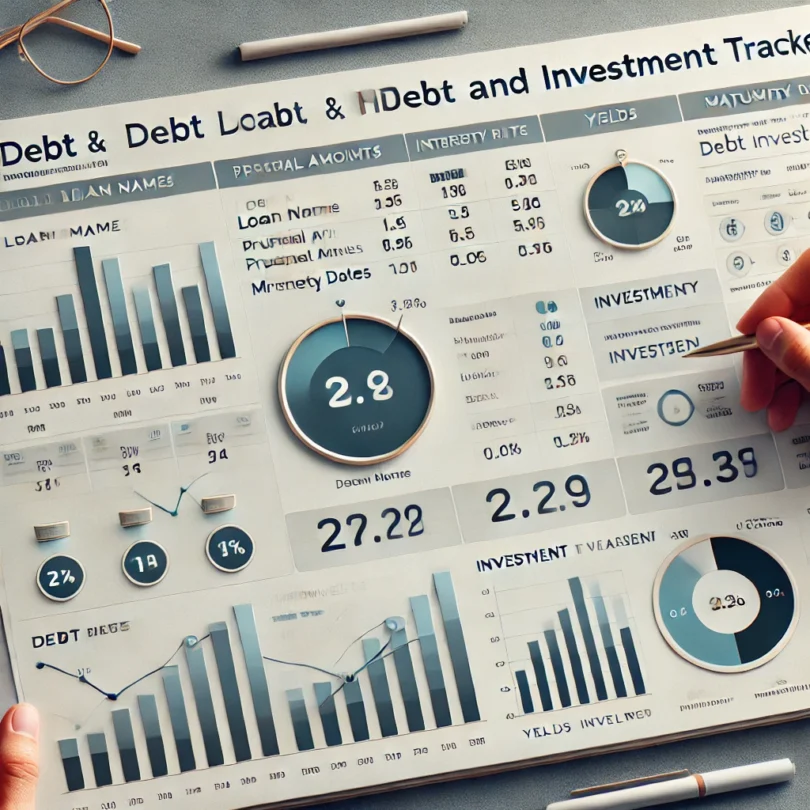Juggling debt repayments and investment opportunities can feel overwhelming. Between tracking loan maturity dates, monitoring fluctuating interest rates, and comparing investment yields, it’s easy for critical details to slip through the cracks. Disorganization can lead to missed payments, suboptimal returns, or even financial risks. Enter the Debt and Investment Tracker —a centralized dashboard that simplifies financial management.
In this blog, we’ll explore how to build your own tool to stay on top of debts and investments effortlessly.
The Problem: Chaos in Financial Tracking** Manually tracking debts and investments often means:
– Scattered spreadsheets or sticky notes for loan due dates. – Forgotten variable interest rate adjustments.
– Overlooking investment opportunities with better returns. – Stress from last-minute debt repayments or reinvestment decisions. Without a unified system, you risk financial inefficiency and missed opportunities. —### **The Solution: A Consolidated Dashboard** A **Debt and Investment Tracker** dashboard solves these issues by: 1. **Consolidating debt schedules** (principal, interest rates, maturity dates). 2. **Monitoring live interest rates** for loans and savings instruments. 3. **Comparing investments** side-by-side (ROI, risk, liquidity). 4. **Visualizing timelines** for debt maturities and investment horizons. Let’s build one! —### **How to Create Your Own Debt and Investment Tracker** *No coding required!* #### **Step 1: Choose Your Platform** Start with user-friendly tools like **Google Sheets** or **Excel** (both support formulas and charts). For advanced users, tools like Power BI or Python (with libraries like Plotly) add interactivity. #### **Step 2: Set Up Your Debt Schedule** Create a table to log all debts (credit cards, mortgages, personal loans): | Debt Name | Principal | Interest Rate | Maturity Date | Monthly Payment | |———–|———–|—————|—————|—————–| | Credit Card A | $5,000 | 18% | 12/2025 | $200 | **Tips**: – Use **data validation** for drop-down menus (e.g., fixed vs. variable rates). – Add conditional formatting to highlight debts maturing in <6 months. #### **Step 3: Monitor Interest Rates** For variable-rate debts or investments: – In Google Sheets, use `=GOOGLEFINANCE(“TICKER”)` to pull live rates (e.g., `=GOOGLEFINANCE(“FEDFUNDS”)` for central bank rates). – In Excel, link to financial web data via *Data > From Web*. #### **Step 4: Compare Investment Options** Create an investment table to evaluate options (stocks, bonds, real estate): | Investment | Type | Expected ROI | Risk Level | Liquidity | |————|——|————–|————|———–| | Index Fund | ETF | 7% | Medium | High | **Compare metrics**: Use formulas to calculate net returns or sort by risk-return ratio. #### **Step 5: Visualize Your Data** – **Debt Timeline**: Create a Gantt chart showing maturity dates. – **Investment Performance**: Plot ROI trends with bar graphs. – **Interest Rate Alerts**: Set up color-coded cells for rate hikes. #### **Step 6: Automate Updates** – Use **APIs** (e.g., Alpha Vantage for stock data) or scheduled refreshes in Excel/Sheets. – Add **email alerts** for deadlines using Google Apps Script or Excel macros. #### **Step 7: Secure Your Data** – Password-protect files. – Store sensitive data in encrypted folders or cloud services (e.g., Google Drive with 2FA). —### **Why This Tracker Works** 1. **Centralized Control**: All data in one place. 2. **Informed Decisions**: Compare debt costs vs. investment returns. 3. **Time-Saving**: Automation reduces manual updates. 4. **Proactive Planning**: Visual cues prevent missed deadlines. —### **Conclusion** A DIY Debt and Investment Tracker empowers you to take control of your financial future. Whether you use a simple spreadsheet or a dynamic dashboard, the key is consistency. Start building yours today—your wallet will thank you! **Ready to begin?** Download a free Google Sheets template [here] or customize your own using the steps above. — *About the Author*: [Your Name] is a financial enthusiast passionate about simplifying money management through smart tools. Follow for more tips on budgeting, investing, and tech-driven finance! — **Keywords**: Debt tracker, investment dashboard, financial planning, interest rate monitoring, ROI comparison. By structuring your financial data visually and proactively, you’ll never miss a payment or a profitable opportunity again. Happy tracking! 💸📊






Leave a Comment
You must be logged in to post a comment.